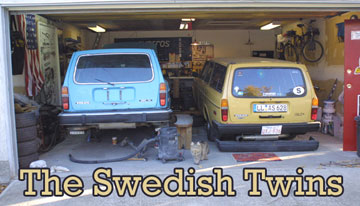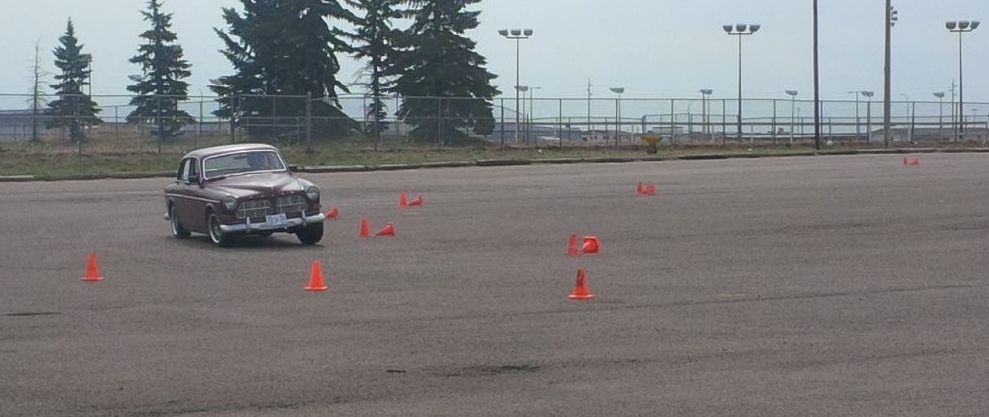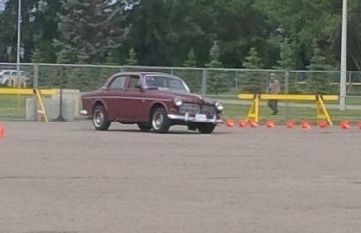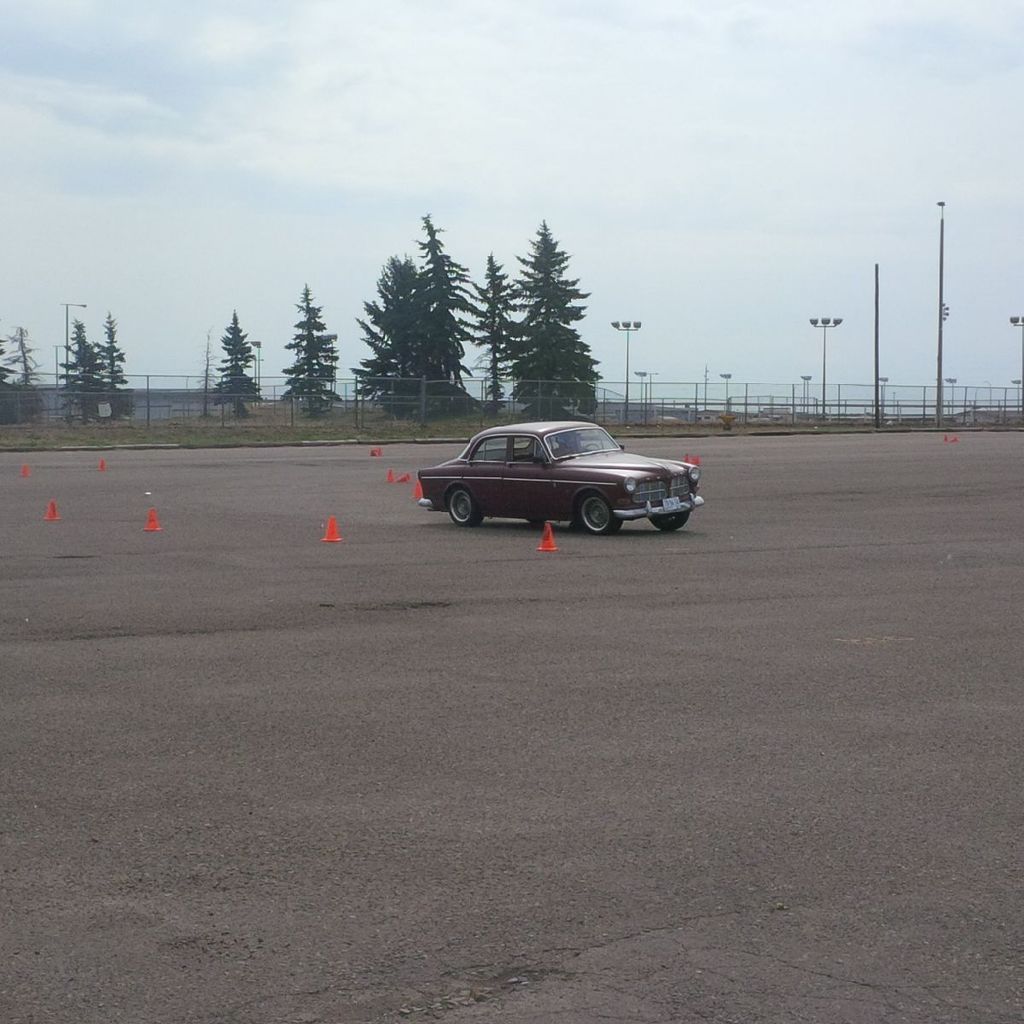I measured up some stock stuff today:
Front coils
.572" wire diameter
4.75" OD
6.5 active coils
11.875" free length
325 lb/in spring rate
91 lb/in wheel rate
Rear coils
.468" wire diameter
4.5" OD
8.5 active coils
15.25" free length
125 lb/in spring and wheel rates
Currently I am running VPD springs all around. The fronts are said to be 250-500 lb/in variable and the rears are 145 lb/in linear. At VPD they claim the actual stock front spring rate is closer to 250 lb/in. I suspect that measurement is taken from the free length position, which uses all 8 or so coils: I only counted coils that showed no signs of having rubbed up against another coil, i.e. 'active' coils. With that in mind, the VPD lowering spring might actually be stiffer than 250 lb/in going down the road, it's tough to say. I'm not sure how much they lower the car but it's 1-1.5" in the rear and around 2-2.5" in the front, but Craig had cut them a little to get the stance he wanted. The fronts are 5" diameter which are also said to be the same as some R-sport springs that were available way back in the day. It's tough to calculate the wheel rate from this at ride height, but the motion ratio is 53% so the wheel rates are 70-140 lb/in if the published spring rates are accurate.
I have on order a pair of 5" x 10.5" 400 lb/in springs and a pair of 5" x 9.5" 550 lb/in springs. The 400 lb-in springs should bring the front up about 1" from where it is now, the 550s should bring it up about 1/2". The 400s give 112 lb/in wheel rate and the 550s will give 154 lb/in.
More Data:

These numbers are calculated with the assumption that my car weighs roughly 2400 lbs, with a 52/48 balance, and with 110 lbs unsprung on each front wheel & 139 lbs unsprung on each rear wheel. I've made fairly educated guesses in most of these departments, combining actual measurements with some common knowledge.
And more info:
Ride Frequencies are a subjective thing, but the guidelines here are pretty simple. For comfort, you want a ride frequency of about 1hz, maybe slightly less, but less than about 0.8hz is a pretty wallowy ride. A very light, very sporty car will have a ride frequency of about 2hz. More than this is considered too harsh for street use (unless you're 21 years old or have <6% body fat). To achieve 2hz or higher you need limited wheel travel or to have some other means of keeping the springs from being unseated at high amplitude wheel travel. For instance, my 550 lb-in spring will compress less than 2" from full free length, any higher spring rate than this and I risk having them flop around at full droop.
So why am I going through all this bother? Simply put, I don't like that much variability in the spring rate. It might be a compromise between ride and handling, but I think both parts suffer more than either part gains. The greatest benefit to a spring like this is that you can lower the car more and not risk bottoming out as easily. Since I don't need/want the car LOW, I would prefer a linear rate spring.
A spring will compress a certain amount with a given load. Remove a given load, the spring will extend. A stiffer spring will compress or extend less for a given load difference than a softer spring. It's pretty easy to see this happening when you load a car up: add weight, the suspension compresses; but you don't often think about what happens when you remove load. The softer spring will extend further, the car will gain more height.
In a corner, load transfers from the inner wheel to the outer wheel due to the height of the center of gravity and the track width. With a CG at around 18" and a track width of 52", a 0.8G corner will take about 315 lbs of load from the inside wheels of my car and put them onto the outside wheels. The outside suspension must absorb this extra load and will compress, while the inside suspension will extend upon release of this load. Stiff springs travel less, so the outside wheel compresses less and the inside wheel extends less.
But a variable rate spring will do something funny: With added load it will compress a certain amount but will then stiffen up and stop moving. When relieved of the same amount of load it will extend further than it will compress when that load is added. So when going around a corner, the outside wheel will compress a little while the inside wheel will extend a lot. This means that in addition to the car rolling "more" (more than it would with a pair of linear springs equal to the stiff part of the variable springs), the car rises up, which raises the center of gravity, which adds load transfer, which adds load, which adds roll, etc.
Similar issues occur when it hits a bump. Imagine a 2" bump: The wheels compressing the suspension increases the load on the springs. This load is then released, which converts into body momentum travelling upwards. If the compressed position puts the springs into their "stiff" zone, they will store and release much more energy in a short distance, and will release it more quickly. This moves the body faster, and as it goes back into the lightly sprung range the body will keep moving further because the lighter springs lose load more slowly. A stiff linear spring would compress the same amount and would store the same energy, but would lose it more quickly and would "bounce" not as high as the variable rate spring. On small bumps the ride is similar to stock, but that makes the big bumps all the more surprising when the nose heads to the sky.
So what you really get with variable rate springs is a spring that uses both heavy coils on big city street bumps, but only one heavy coil in a corner. I'd rather have linear springs that produce the same effect in corners but ride better on the street, or springs that ride the same on the street but work better in the corners. Savvy?
The 400# spring is stiffer in proportion to stock in the same general amount as the VPD rear springs are to stock, which was my first choice of things to try. The idea with the 550# springs is to try something about as stiff as the "stiff" position of the VPD variables and to bring the ride rates and balance more into the sports car range. For reference, a similarly "old" guy as myself just installed 300 lb/in springs in the front of his 242 and that gives a ride frequency in the 2.0 hz range, and he doesn't think it's TOO harsh, so my 550s might be just fine.
More to report when the springs arrive.





















